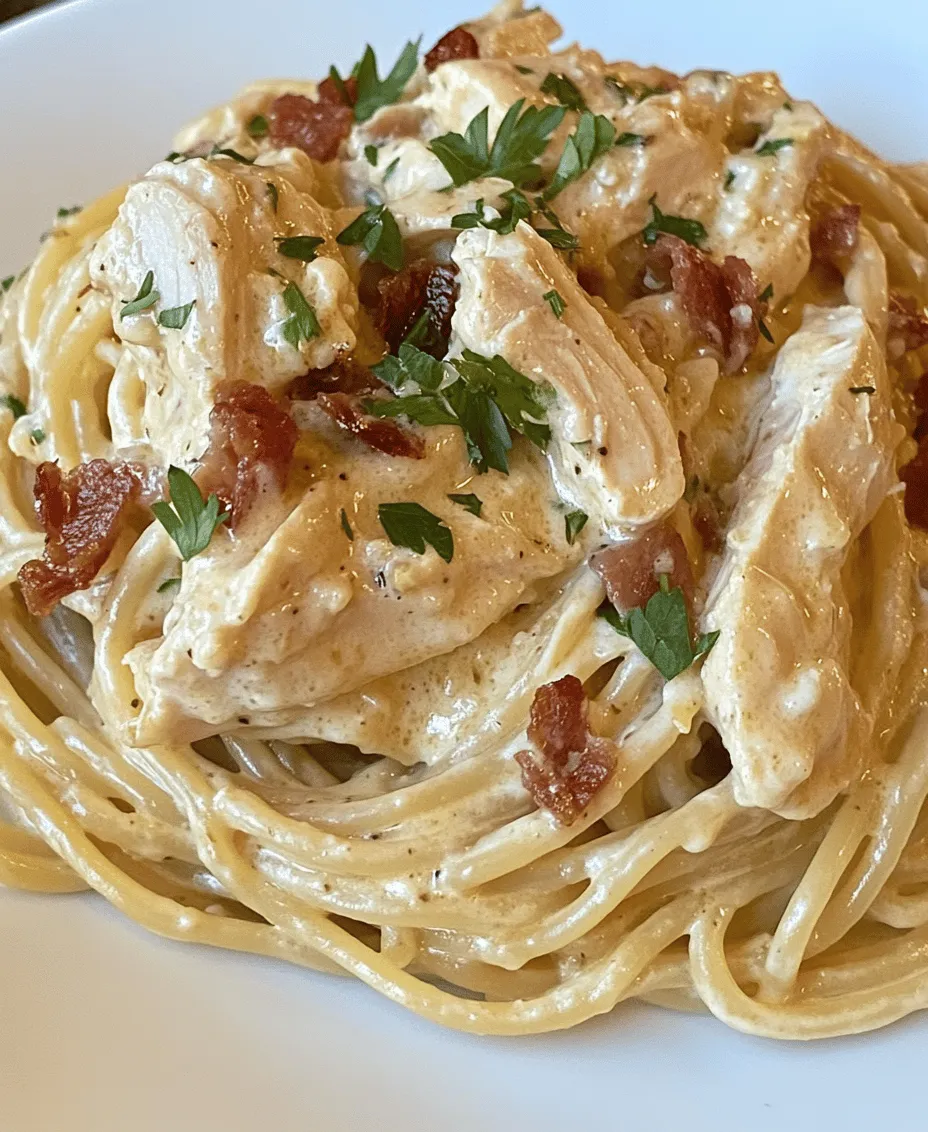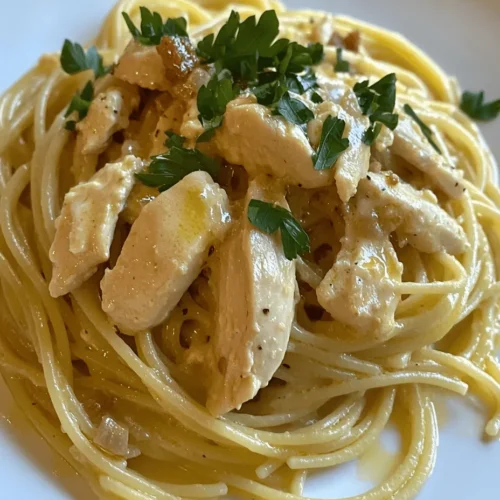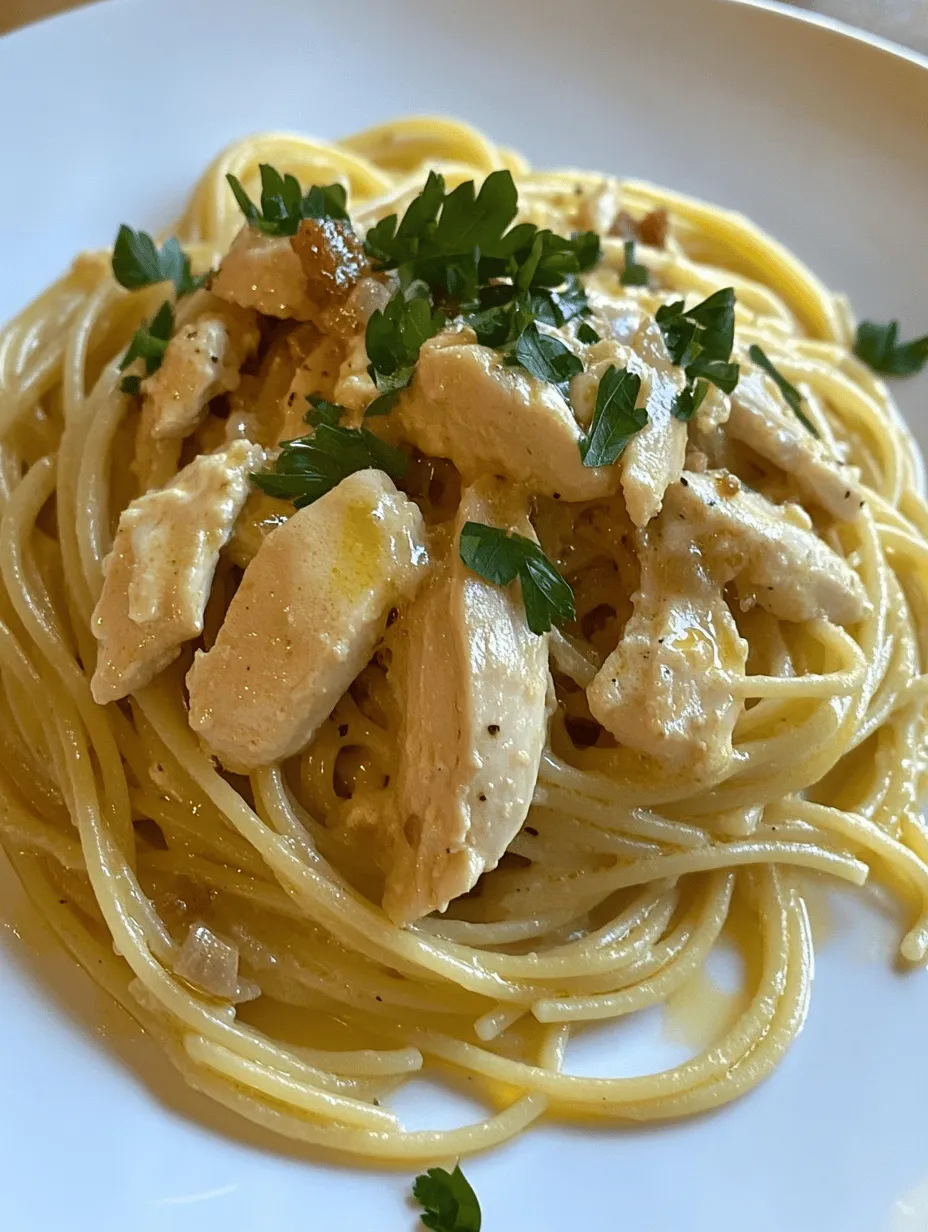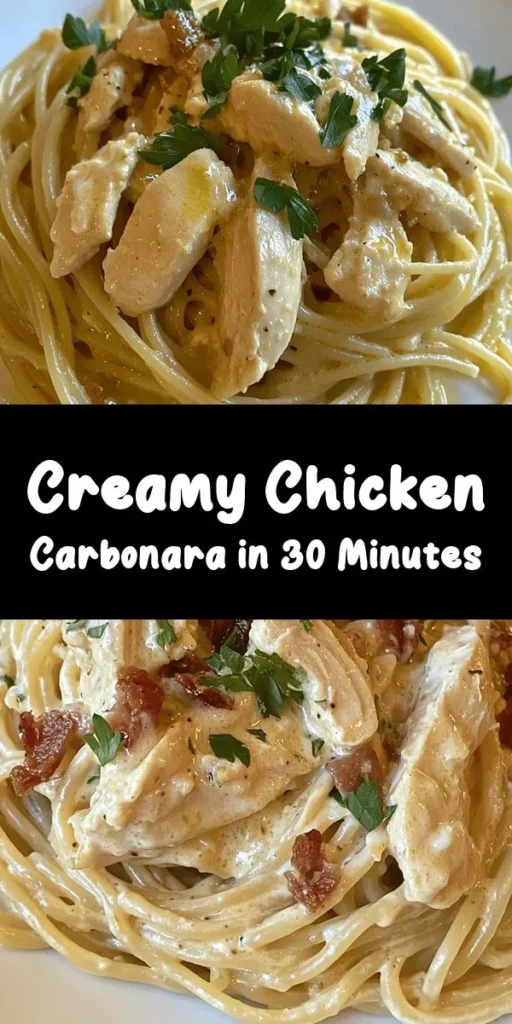Introduction
Chicken Carbonara stands as a beloved staple in Italian cuisine, showcasing the rich tapestry of flavors that this culinary tradition has to offer. This dish is not just a meal; it’s an experience that brings together the comforting embrace of creamy sauce, the tender bite of chicken, and the savory crunch of crispy pancetta. In an age where quick yet satisfying meals are a necessity, Chicken Carbonara emerges as the perfect solution. Whether you’re cooking for yourself or hosting a dinner party, this recipe promises to impress and satisfy.
What makes Chicken Carbonara particularly appealing is its balance of flavors and textures. The creamy sauce coats each strand of pasta, creating an indulgent mouthfeel that pairs beautifully with the succulent chicken and the crispiness of pancetta. The dish is a symphony of taste, where each ingredient plays a crucial role in delivering a comforting, hearty meal.
To achieve the best flavor profile, it’s essential to use high-quality ingredients. From the pasta to the cheese, every element contributes to the overall success of the dish. If you’re ready to elevate your cooking game and whip up a delightful Chicken Carbonara that will have everyone asking for seconds, let’s delve into its rich history and explore the ingredients that make this dish truly special.
The History of Carbonara
The origins of Carbonara are steeped in a blend of folklore and culinary evolution. While its exact beginnings are somewhat murky, it is widely believed that Carbonara emerged in the mid-20th century in Rome. The dish is thought to have been a favorite among the Italian charcoal workers (carbonari) who would prepare it using simple, readily available ingredients. The traditional recipe has endured over the decades, but it has also undergone various adaptations that reflect the evolving palate of modern diners.
Traditionally, Carbonara consists of a few key ingredients: guanciale (cured pork cheek), eggs, Pecorino Romano cheese, and black pepper. These ingredients come together to create a creamy, rich sauce without the need for heavy cream. However, in contemporary versions, especially those outside Italy, adaptations have introduced chicken, heavy cream, and even vegetables, making the dish more accessible and appealing to a broader audience.
Culturally, Carbonara has transcended its Roman roots to become a beloved dish worldwide. It represents the quintessential Italian approach to cooking—simple yet full of flavor. As people around the globe have embraced Italian cuisine, Chicken Carbonara has found its place in homes and restaurants alike, becoming a go-to for many seeking comfort food with a gourmet touch.
Understanding the Ingredients
To create the best-ever Chicken Carbonara, it’s crucial to understand the role of each ingredient. Here’s a closer look at the stars of this dish:
Pasta: Spaghetti or Fettuccine?
When it comes to the pasta, both spaghetti and fettuccine are excellent choices for Carbonara. Spaghetti is the traditional option, offering a classic texture and the ability to cling to the creamy sauce beautifully. Fettuccine, on the other hand, provides a broader surface area that can enhance the overall indulgence of the dish. Ultimately, the choice depends on personal preference; both options will yield a delicious result.
Chicken: Boneless, Skinless Breasts
For the protein component of this dish, boneless, skinless chicken breasts are recommended. They are lean, tender, and cook quickly, making them perfect for weeknight meals. The absence of skin allows the flavors of the sauce and pancetta to shine through without being overshadowed. Additionally, chicken breasts are versatile, easily absorbing the flavors of the other ingredients.
Pancetta vs. Bacon
The debate between pancetta and bacon often arises when making Carbonara. While both provide a delicious salty, savory element, pancetta is the more traditional choice. It has a softer texture and a more delicate flavor compared to bacon, which can be smokier due to its curing process. If you choose to use bacon, opt for a less smoky variety to maintain the dish’s authenticity. When cooking, ensure that either option is crisped to perfection to add that essential texture contrast in each bite.
Eggs and Cheese: The Creamy Sauce Foundation
The heart of any Carbonara is its sauce, made primarily from eggs and cheese. The eggs create a luscious, creamy base, while the cheese—typically Pecorino Romano—adds a sharp, salty flavor that elevates the dish. When combined with the heat of the pasta, the eggs create a silky sauce that clings to each strand, enveloping it in rich flavor. It’s essential to use fresh, high-quality eggs for the best results, as they will enhance the overall taste and texture of the dish.
Heavy Cream: Enhancing Richness
While traditional Carbonara does not include heavy cream, many modern recipes, including our Chicken Carbonara, incorporate it to enhance the richness and creaminess of the sauce. The cream adds a velvety texture that makes the dish even more indulgent. If you prefer a lighter version, you can reduce the amount of cream or eliminate it altogether, allowing the eggs and cheese to deliver the desired creaminess.
Seasoning: Salt and Black Pepper
Seasoning is a critical aspect of any recipe, and Chicken Carbonara is no exception. A generous amount of freshly cracked black pepper is essential for depth and a hint of spice. It complements the richness of the sauce and adds an aromatic kick that is characteristic of classic Carbonara. Salt should be used judiciously, as the pancetta and cheese already provide a significant amount of sodium.
Fresh Parsley: A Flavorful Garnish
Finally, fresh parsley serves as a vibrant garnish that not only adds a pop of color but also brings a hint of freshness to the dish. Chopped parsley can be sprinkled on top just before serving, enhancing the presentation and providing a light contrast to the rich flavors of the Carbonara.
Initial Steps to Prepare Chicken Carbonara
Now that we’ve explored the history and ingredients of Chicken Carbonara, it’s time to dive into the cooking process. This dish is not only delicious but also relatively quick to prepare, making it ideal for busy weeknights or when you want to impress guests without spending hours in the kitchen. Here are the initial steps to get started on your best-ever Chicken Carbonara.
1. Gather Your Ingredients: Before you start cooking, ensure you have all the ingredients ready. This includes pasta (spaghetti or fettuccine), boneless skinless chicken breasts, pancetta, eggs, Pecorino Romano cheese, heavy cream, fresh parsley, salt, and black pepper. Having everything on hand will streamline the cooking process.
2. Cook the Pasta: Begin by bringing a large pot of salted water to a boil. Once boiling, add your pasta and cook according to the package instructions until al dente. Remember to reserve a cup of pasta water before draining, as this starchy liquid can be added later to achieve the desired sauce consistency.
3. Prepare the Chicken: While the pasta cooks, take your chicken breasts and season them generously with salt and pepper. Heat a large skillet over medium-high heat and add a drizzle of olive oil. Once hot, add the chicken to the skillet and cook for about 6-7 minutes on each side or until fully cooked through and golden brown. Remove the chicken from the skillet and allow it to rest for a few minutes before slicing it into bite-sized pieces.
4. Crisp the Pancetta: In the same skillet used for the chicken, add the pancetta. Cook it over medium heat until it becomes crispy, about 4-5 minutes. The rendered fat from the pancetta will add flavor to the dish, so be sure to scrape any browned bits from the bottom of the pan as you cook.
5. Combine Ingredients: Once the pancetta is crispy, reduce the heat and add the cooked pasta directly to the skillet. Toss the pasta in the pancetta fat to coat it thoroughly. This step is crucial as it infuses the pasta with flavor.
6. Make the Sauce: In a mixing bowl, whisk together the eggs, heavy cream, grated Pecorino Romano cheese, and a generous amount of black pepper. This mixture will be your sauce. As you’re combining it with the hot pasta, the residual heat will cook the eggs gently, creating a creamy sauce.
These initial steps will set the stage for a flavorful Chicken Carbonara that will delight your taste buds and impress your guests. As you continue with the recipe, remember to adjust the seasoning to your liking and enjoy the process of creating this Italian classic right in your own kitchen.

Step-by-Step Instructions for Best-Ever Chicken Carbonara
Creating the best-ever Chicken Carbonara involves a few key steps that ensure a deliciously creamy and flavorful dish. Follow these detailed instructions carefully to achieve the perfect balance of textures and flavors.
Cooking the Pasta
Start by boiling a large pot of salted water. The salt is crucial as it enhances the flavor of the pasta. Once the water reaches a rolling boil, add your choice of pasta (spaghetti, fettuccine, or linguine work best). It’s essential to cook the pasta until it reaches an al dente texture, which means it should be firm to the bite. This not only provides a better texture but also helps the pasta hold its shape when combined with the sauce.
Before draining the pasta, reserve about a cup of the pasta water. This starchy water is a secret weapon in achieving a creamy sauce later on. Once you’ve saved the water, drain the pasta and set it aside.
Cooking Chicken and Pancetta
While the pasta is cooking, you can prepare the chicken and pancetta. In a large skillet over medium heat, add a couple of tablespoons of olive oil. Once the oil is hot, add diced pancetta and sauté until it becomes crispy and golden brown, about 5-7 minutes. The rendered fat from the pancetta will add incredible flavor to your dish.
Next, add the chicken breast pieces to the skillet. Season them generously with salt and pepper. Cook the chicken for about 6-8 minutes, or until it is fully cooked through and reaches an internal temperature of 165°F (75°C). Stir occasionally to ensure even browning.
Once the chicken is cooked, remove the skillet from heat. This step is crucial to prevent the chicken from overcooking and becoming dry.
Preparing the Sauce
Now, let’s prepare the luscious sauce that will coat the pasta beautifully. In a mixing bowl, whisk together 3 large eggs, 1 cup of heavy cream, and a generous 1 cup of freshly grated Parmesan cheese. The mixture should be smooth and creamy. This combination of eggs and cream is what gives carbonara its signature richness.
Make sure to whisk vigorously to ensure that the eggs are well combined with the cream and cheese. This step is essential because it will create a velvety sauce that clings to the pasta instead of scrambling when heated.
Combining Ingredients
With all components ready, it’s time to bring everything together. Return the skillet with the chicken and pancetta to low heat. Add the drained pasta directly into the skillet, tossing it gently to combine with the chicken and pancetta.
Now, remove the skillet from heat to avoid scrambling the eggs. Quickly pour the egg and cream mixture over the hot pasta. The residual heat from the pasta will gently cook the eggs and create a silky sauce. Stir quickly and continuously, adding reserved pasta water a little at a time until you achieve your desired sauce consistency. The goal is to have a creamy coating on the pasta without it being too runny.
Final Touches
Once the pasta is well coated, taste and adjust the seasoning. A pinch of salt or a crack of freshly ground black pepper can elevate the dish even further. Finally, garnish with freshly chopped parsley for a pop of color and a hint of freshness. Serve immediately, as carbonara is best enjoyed fresh.
Tips for Perfecting Your Chicken Carbonara
1. Adjusting the Recipe for Dietary Preferences: If you’re looking to make a gluten-free version, substitute regular pasta with gluten-free pasta. For a vegetarian option, you can omit the chicken and pancetta altogether and replace them with sautéed mushrooms or zucchini for added flavor and texture.
2. Storage and Reheating Suggestions: If you have leftovers, store them in an airtight container in the refrigerator for up to 3 days. When reheating, do so gently over low heat, adding a splash of reserved pasta water or cream to help restore the creamy consistency.
3. Pairing Suggestions: Chicken Carbonara pairs beautifully with a side salad dressed with a light vinaigrette. For wine lovers, a crisp Pinot Grigio or a light-bodied red like Chianti complements the rich flavors of the dish well.
Nutritional Information
For those mindful of their dietary intake, here’s a breakdown of the nutritional information per serving of Chicken Carbonara:
– Calories: Approximately 650
– Protein: 35g
– Fat: 30g
– Carbohydrates: 70g
Health Benefits of Key Ingredients
– Chicken: A great source of lean protein, chicken helps in building muscle and maintaining overall health.
– Dairy: The heavy cream and Parmesan cheese provide calcium and essential vitamins, although it’s wise to enjoy them in moderation.
Tips for a Healthier Dish
To make Chicken Carbonara a bit healthier without sacrificing flavor, consider using half-and-half instead of heavy cream. You can also reduce the amount of cheese or use a lower-fat cheese option. Adding in more vegetables like spinach or peas can increase the overall nutritional value while adding color and freshness to the dish.
Conclusion
In summary, this Best-Ever Chicken Carbonara recipe highlights the beauty of simple, high-quality ingredients coming together to create a rich and satisfying meal. From the perfectly cooked pasta to the creamy sauce that envelops each strand, this dish is sure to impress anyone who tries it.
Don’t hesitate to experiment with the recipe, adding your own twist or variation. Perhaps you’d like to incorporate different proteins or vegetables, or adjust the seasoning to suit your taste. Cooking is a joy that allows for creativity and personalization, so enjoy the process and make it your own.
Whether you’re preparing this dish for a special occasion or a cozy weeknight dinner, the satisfaction of enjoying homemade Italian cuisine is truly unparalleled. Embrace the flavors, share your creations, and savor the experience of cooking for yourself and your loved ones.



